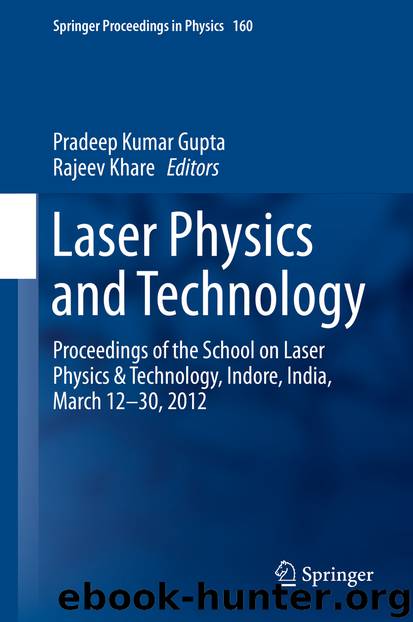Laser Physics and Technology by Pradeep Kumar Gupta & Rajeev Khare

Author:Pradeep Kumar Gupta & Rajeev Khare
Language: eng
Format: epub
Publisher: Springer India, New Delhi
In 1966, Ambartsumyan et al. realized a laser cavity in which one mirror of the Fabry-Pérot cavity was replaced by a scattering surface which results in the multiple scattering of light in the cavity [9, 10]. However, as it lacked spectral purity, directionality, and coherence, it did not generate much interest in the scientific community.
In 1968, Letokhov [11] theoretically proposed self-generation of light in a RAM, in the diffusive regime. By solving the diffusion equation for the photon energy density in the presence of uniform and linear gain, he showed that as the volume of the scattering medium exceeds the critical volume V cr (≈(l*l g /3)3/2), the photon energy density increases exponentially with time. Because this process of photon generation is analogous to the multiplication of neutrons in an atomic bomb [12], this device is sometimes called a “photonic bomb.” In reality the light intensity will not diverge (there is no explosion) because gain depletion quickly sets in and l g increases.
For a long time, Letokhov’s theoretical work was not followed by experiments. However, in the late 1980s, several reports of laser-like emission in powdered luminophosphors appeared [13–20], opening up the field of random lasing. In a powder laser, it is hard to tell whether the feedback is provided by multiple scattering or internal reflection, because the gain medium and scattering elements are not separated in the powder. In 1994, Lawandy et al. [21] demonstrated isotropic laser-like emission from an optically pumped laser dye solution (rhodamine 640 perchlorate in methanol), in which point-like scatterers (TiO2 microspheres of mean diameter <1 μm) were randomly suspended. A collapse of the linewidth of emission was observed above a threshold pump power and was interpreted as the onset of lasing when the gain due to the enhanced path lengths within the active medium, brought about by multiple scattering, exceeded the intensity loss from the system. Linewidth collapse is a well-known phenomenon which occurs even in homogeneous amplifying media due to amplified spontaneous emission (ASE). The remarkable fact in these experiments was that the threshold of the pump power at which the emission spectrum collapsed drastically was almost two orders of magnitude smaller in the case of microsphere-laser dye suspension, compared to the case of ASE in the neat dye solution. Further, the peak emission intensity was shown to increase by more than three orders of magnitude upon the addition of scatterers [22]. As opposed to the crushed laser crystal RAM, the dye-scatterer RAM separated the scattering and amplifying media, thereby allowing the scattering strength to be varied independent of the optical gain via scatterer density and dye concentration, respectively. This in turn facilitated a systematic study of the scattering effect on feedback. Since this observation, many experiments were carried out to examine the origin and various features of the narrow-linewidth emission reported by them. Simultaneously, several theoretical studies [23–27] have been conducted to provide models that will efficiently describe the behavior of these materials and help in an understanding of the underlying mechanisms that are responsible for their laser-like characteristics.
Download
This site does not store any files on its server. We only index and link to content provided by other sites. Please contact the content providers to delete copyright contents if any and email us, we'll remove relevant links or contents immediately.
| Automotive | Engineering |
| Transportation |
Whiskies Galore by Ian Buxton(41524)
Introduction to Aircraft Design (Cambridge Aerospace Series) by John P. Fielding(32883)
Small Unmanned Fixed-wing Aircraft Design by Andrew J. Keane Andras Sobester James P. Scanlan & András Sóbester & James P. Scanlan(32569)
Craft Beer for the Homebrewer by Michael Agnew(17927)
Turbulence by E. J. Noyes(7690)
The Complete Stick Figure Physics Tutorials by Allen Sarah(7135)
Kaplan MCAT General Chemistry Review by Kaplan(6589)
The Thirst by Nesbo Jo(6432)
Bad Blood by John Carreyrou(6270)
Modelling of Convective Heat and Mass Transfer in Rotating Flows by Igor V. Shevchuk(6219)
Learning SQL by Alan Beaulieu(6029)
Weapons of Math Destruction by Cathy O'Neil(5820)
Man-made Catastrophes and Risk Information Concealment by Dmitry Chernov & Didier Sornette(5641)
Digital Minimalism by Cal Newport;(5384)
Life 3.0: Being Human in the Age of Artificial Intelligence by Tegmark Max(5182)
iGen by Jean M. Twenge(5151)
Secrets of Antigravity Propulsion: Tesla, UFOs, and Classified Aerospace Technology by Ph.D. Paul A. Laviolette(4974)
Design of Trajectory Optimization Approach for Space Maneuver Vehicle Skip Entry Problems by Runqi Chai & Al Savvaris & Antonios Tsourdos & Senchun Chai(4837)
Electronic Devices & Circuits by Jacob Millman & Christos C. Halkias(4739)
